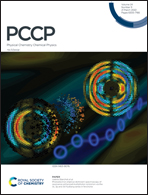Prediction of dielectric constants of ABO3-type perovskites using machine learning and first-principles calculations†
Abstract
In this study, the machine-learning method, combined with density functional perturbation theory (DFPT) calculations, was implemented to predict and validate the dielectric constants of ABO3-type perovskites. For the construction of the training database, the dielectric constants of 7113 inorganic materials were extracted from the Materials Project. The chemical, structural, and physical descriptors were generated and trained using the gradient-boosting-based regressor after feature engineering. The prediction accuracies were 0.83 and 0.67 (R2) and 0.12 and 0.26 (root mean square error) for the electronic and ionic contributions to the dielectric constant, respectively. The constructed surrogate model was then employed to predict the dielectric constants of the ABO3-type perovskites (216 structures), whose thermodynamic stabilities were satisfactory. The predicted values were validated using DFPT calculations. The constructed database was further used to develop a surrogate model for the prediction of dielectric constants. The final R2 prediction accuracies reached 0.79 (electronic) and 0.67 (ionic).



 Please wait while we load your content...
Please wait while we load your content...